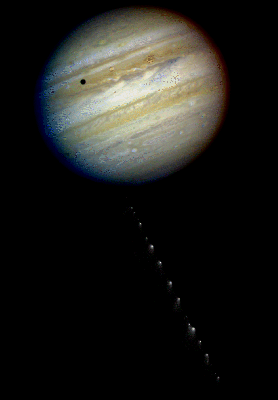

NOTE: Click on the image to view it at its highest resolution.
PHOTO RELEASE NO.: STScI-PR94-26a
FOR RELEASE: July 7, 1994
This is a composite photo, assembled from separate images of Jupiter and comet P/Shoemaker-Levy 9, as imaged by the Wide Field & Planetary Camera-2 (WFPC-2), aboard NASA's Hubble Space Telescope (HST).
Jupiter was imaged on May 18, 1994, when the giant planet was at a distance of 420 million miles (670 million km) from Earth. This "true-color" picture was assembled from separate HST exposures in red, blue, and green light. Jupiter's rotation between exposures creates the blue and red fringe on either side of the disk. HST can resolve details in Jupiter's magnificent cloud belts and zones as small as 200 miles (320 km) across (wide field mode). This detailed view is only surpassed by images from spacecraft that have traveled to Jupiter.
The dark spot on the disk of Jupiter is the shadow of the inner moon Io. This volcanic moon appears as an orange and yellow disk just to the upper right of the shadow. Though Io is approximately the size of Earth's Moon (but 2,000 times farther away), HST can resolve surface details.
When the comet was observed on May 17, its train of 21 icy fragments stretched across 710 thousand miles (1.1 million km) of space, or 3 times the distance between Earth and the Moon. This required six WFPC exposures along the comet train to include all the nuclei. The image was taken in red light.
The apparent angular size of Jupiter relative to the comet, and its angular separation from the comet when the images were taken, have been modified for illustration purposes.
Credit: H.A. Weaver, T.E. Smith (Space Telescope
Science Institute) and J.T. Trauger, R.W. Evans
(Jet Propulsion Laboratory), and NASA
![]() Images, Images, Images
Images, Images, Images
